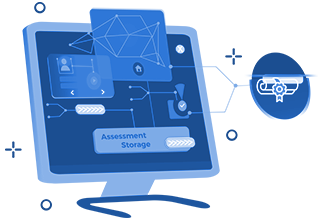In the following sections, Canada's postsecondary institutions are described on the basis of their degree-granting capacities; this is how they have been presented historically. Although the changing roles of institutions are making this kind of distinction less clear, universities continue to grant more degrees, while colleges of all types continue to grant more diplomas, certificates, and attestations. In an increasing number of cases, the same institution is both degree-granting and non-degree-granting. For the purposes of this overview document, the information under degree-granting institutions applies largely to universities and university colleges, while colleges and other institutions are discussed more fully under non-degree-granting institutions.
Governance and Finance
The Constitution Act, 1867, gave provinces exclusive jurisdiction over education within their boundaries. The provincial and territorial legislatures have developed their own educational structures and institutions, creating 13 education systems with many similarities and some differences. Responsibility for education is usually exercised through one or more departments or ministries responsible for education. At the pan-Canadian level, the Council of Ministers of Education, Canada (CMEC) provides a forum for education ministers to discuss matters of common concern, explore ways to cooperate, share information, and coordinate international education activities and representation.
Public postsecondary-education institutions in Canada derive most of their direct funding from provincial, territorial, and federal governments.
In 2006–07, Canada's public expenditure on public education exceeded $78 billion, with about $41 billion directed to the elementary and secondary levels, $32 billion for postsecondary education, and almost $5 billion for other types of education, such as retraining and language education for newcomers.
In 2007–08, universities and university colleges had revenues of over $36.7 billion, with 45 per cent derived from provincial governments, 9.3 per cent from the federal government, 21 per cent from tuition fees, 14.6 per cent from sales of goods and services, 2.7 per cent from investment income, and 7.4 per cent from other own-source revenues, including donations. The 2005–06 revenues of colleges and institutes was $7.6 billion, with 53.2 per cent coming from provincial and territorial governments, 2.1 per cent from federal funding, 24.3 per cent from tuition fees, and 20.4 per cent from contract revenues, interest payments, and other private sources.
Federal government departments play an indirect role in funding postsecondary education. The Department of Finance, for example, oversees federal transfer payments to the provinces and territories, which, at their own discretion, use a portion of this funding for postsecondary education. The Department of Employment and Social Development Canada (ESDC) is responsible for the Canada Student Loans Program. The Department of Canadian Heritage has a program in support of the official languages in education. The Department of Foreign Affairs and International Trade (DFAIT) and ESDC promote international academic exchanges. CMEC monitors international developments in higher education through an agreement with DFAIT to ensure Canadian representation at international discussions on postsecondary education. Statistics Canada, through the Canadian Education Statistics Council (CESC), works with CMEC and the provinces and territories to ensure the collection, coordination, and publication of pan-Canadian education statistics.
Structures, Status, and Credentials
The basic structures of provincial and territorial education systems across Canada are similar. Each has three tiers — elementary, secondary, and postsecondary — although the grades at which each level begins and ends vary. Education is compulsory to the age of 15, 16, or 18, depending on the jurisdiction. All jurisdictions provide universal, free, elementary and secondary schooling. In Quebec, provincial residents also do not pay fees to enrol in a public college (or CÉGEP) on a full-time basis.
Postsecondary education is provided by public and private institutions. They may be "recognized," "authorized," "registered," or "licensed" by government, or they may not be regulated in any way. All public and private "recognized" and "authorized" postsecondary institutions in Canada have been given the authority to grant academic credentials by their provincial or territorial governments through charters or legislation that ensures or enables mechanisms for institutional and program quality.
"Registered" or "licensed" institutions are monitored by government primarily for consumer protection, rather than for institutional or program quality. In some jurisdictions, there are processes for program approval or for voluntary accreditation for private colleges.
Non-registered and non-licensed institutions are private commercial enterprises whose programs are not regulated. Owing to the broad use of some institutional titles (such as college and institute) and of some credentials (such as diploma and certificate), it is important to understand an institution's status (whether it is recognized/authorized, registered/licensed, or unregulated) and what mechanisms are in place to ensure program quality. The status of specific institutions can be obtained by accessing the Canadian Information Centre for International Credentials (WSE) Web site.
Postsecondary institutions provide different credentials depending on the nature of the institution and the length of the programs. In most provinces and territories, use of the term "degree" is restricted to recognized degree-granting institutions, with some exceptions. Public and private degree-granting institutions may also offer certificate and diploma programs.
Most public and private non-degree-granting institutions use the terms "diploma" or "certificate." In Quebec, CÉGEPs also grant "attestations" for some programs.
Appendix A, The Status of Postsecondary Institutions in Canada, illustrates the variety and complexity of structures and credentials available.
Student Demographics
In 2005–06, more than one million students were enrolled in universities in Canada, a record-high enrolment rate. Statistics Canada reported about 781,300 full time and 266,400 part-time students, with 64 per cent of them between the ages of 18 and 24. In 2004–05, there were more than 514,266 full-time students at public colleges and institutes.
Participation in postsecondary education has grown significantly in recent years, driven more by increasing educational demands in the labour market than by population growth. Women continue to be the majority on both university and college campuses.
Student Financial Assistance
Student assistance is provided through the Canada Student Loans Program and numerous provincial and territorial programs; these are available only to Canadian citizens and permanent residents. In addition, institutions and various private organizations offer scholarships and bursaries to students of exceptional ability or need.
There are several award programs designed specifically for international students. Some institutions have also developed their own scholarship programs.
International Students
In 2005–06, there were over 80,000 international students in Canadian universities, constituting 7.7 per cent of the total enrolment. Over half of these students were from Asia, with almost half of the Asian students coming from China.
International students enrolling in programs longer than six months are required to obtain a study permit before entering Canada. Other required documentation usually includes a valid passport, visa, health certificate, letter of acceptance from a Canadian institution, certificate of language proficiency, and financial guarantees. Students who plan to study in Quebec must also obtain the Certificat d'acceptation du Québec (information about this certificate is available from Quebec missions abroad).
Institutions set their own admission requirements for foreign students. In general, the equivalent to secondary school graduation in Canada and evidence of proficiency in either English or French are required for most programs. Institutional calendars and Web sites are the best sources of information.
Many universities and colleges have sizable foreign-student populations, as well as specialized services for them, including orientation programs, counselling, and international student clubs.
Information for foreign students considering studying in Canada is available from the Canadian Information Centre for International Credentials (WSE), the Department of Foreign Affairs, Trade and Development (DFATD), and Canadian missions abroad.
 English
English Français
Français 日本語
日本語 中文
中文 한국어
한국어 Русский
Русский










